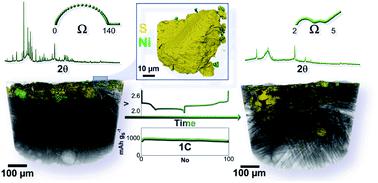当前位置:
X-MOL 学术
›
Sustain. Energy Fuels
›
论文详情
Our official English website, www.x-mol.net, welcomes your feedback! (Note: you will need to create a separate account there.)
Investigating high-performance sulfur–metal nanocomposites for lithium batteries
Sustainable Energy & Fuels ( IF 5.6 ) Pub Date : 2020-03-16 , DOI: 10.1039/d0se00134a Vittorio Marangon 1, 2, 3, 4 , Daniele Di Lecce 5, 6, 7, 8, 9 , Fabio Orsatti 1, 2, 3, 4 , Dan J. L. Brett 5, 6, 7, 8, 9 , Paul R. Shearing 5, 6, 7, 8, 9 , Jusef Hassoun 1, 2, 3, 4, 10
Sustainable Energy & Fuels ( IF 5.6 ) Pub Date : 2020-03-16 , DOI: 10.1039/d0se00134a Vittorio Marangon 1, 2, 3, 4 , Daniele Di Lecce 5, 6, 7, 8, 9 , Fabio Orsatti 1, 2, 3, 4 , Dan J. L. Brett 5, 6, 7, 8, 9 , Paul R. Shearing 5, 6, 7, 8, 9 , Jusef Hassoun 1, 2, 3, 4, 10
Affiliation

|
Herein, for the first time, we study the reversible conversion in a lithium cell of a novel sulfur–metal nanocomposite by combining X-ray computed tomography data at the micro- and nanoscales with the electrochemistry. The electrode is obtained at mild temperatures according to an alternative approach, including metal nanoparticles of either tin or nickel in bulk molten sulfur in the corresponding weight ratio of 85 : 15. We show that this pathway leads to the formation of high-performance electrodes, matching the state-of-the-art results obtained from the best carbonaceous composites. Indeed, lithium–sulfur (Li–S) cells at a working voltage of about 2.2 V ensure sulfur-mass-referred capacity approaching 1400 mA h g−1 at a C/3 rate and 740 mA h g−1 at a rate as high as 3C (1C = 1675 mA h g−1), with a coulombic efficiency close to 100% and stable cycling trends over 100 cycles. High-resolution imaging sheds light on the characteristic morphological features of the electrode allowing these remarkable performances, and reveals the beneficial effects of the incorporation of metal nanoparticles within the sulfur phase. The various investigation techniques, with a particular focus on three-dimensional imaging, suggest sulfur electrodeposition upon charging, preferentially adjacent to the electron-conductive centers within the electrode support as well as that on metal clusters. A massive microstructural reorganization is observed during the first cycle in lithium cells with concomitant remarkable enhancements in the electrode charge transfer and variation in the reaction potentials. This process is accompanied by substantial electrode amorphization and migration of the active material toward the current-collector bulk. The results obtained in this work, as well as a comprehensive study with an ad hoc design for sulfur electrodes, suggest alternative strategies for ultimately achieving actual Li–S cell improvement.
中文翻译:

研究用于锂电池的高性能硫金属纳米复合材料
在此,我们首次通过结合微观和纳米级的X射线计算机断层扫描数据与电化学技术,研究了新型硫金属纳米复合材料在锂电池中的可逆转化。根据另一种方法,可以在温和的温度下获得电极,其中包括块状熔融硫中锡或镍的金属纳米颗粒,其重量比为85:15。我们表明,这种途径可导致形成高性能电极,匹配从最佳含碳复合材料获得的最新结果。确实,锂-硫(Li-S)电池在约2.2 V的工作电压下可确保以C / 3速率达到1400 mA hg -1且达到740 mA hg -1的硫质量基准容量速率高达3C(1C = 1675 mA hg -1),库仑效率接近100%,并且在100个循环中保持稳定的循环趋势。高分辨率成像揭示了电极的特征形态特征,从而实现了这些出色的性能,并揭示了在硫相中掺入金属纳米颗粒的有益效果。各种研究技术,尤其着重于三维成像,建议在充电时进行硫电沉积,优先靠近电极支架内的电子传导中心以及金属簇上的电子传导中心。在锂电池的第一个循环中,观察到大规模的微观结构重组,同时电极电荷转移和反应电势变化也显着增强。该过程伴随着电极的大量非晶化和活性材料向集电器主体的迁移。在这项工作中获得的结果,以及对硫电极的临时设计提出了最终实现实际Li-S电池改进的替代策略。
更新日期:2020-03-16
中文翻译:

研究用于锂电池的高性能硫金属纳米复合材料
在此,我们首次通过结合微观和纳米级的X射线计算机断层扫描数据与电化学技术,研究了新型硫金属纳米复合材料在锂电池中的可逆转化。根据另一种方法,可以在温和的温度下获得电极,其中包括块状熔融硫中锡或镍的金属纳米颗粒,其重量比为85:15。我们表明,这种途径可导致形成高性能电极,匹配从最佳含碳复合材料获得的最新结果。确实,锂-硫(Li-S)电池在约2.2 V的工作电压下可确保以C / 3速率达到1400 mA hg -1且达到740 mA hg -1的硫质量基准容量速率高达3C(1C = 1675 mA hg -1),库仑效率接近100%,并且在100个循环中保持稳定的循环趋势。高分辨率成像揭示了电极的特征形态特征,从而实现了这些出色的性能,并揭示了在硫相中掺入金属纳米颗粒的有益效果。各种研究技术,尤其着重于三维成像,建议在充电时进行硫电沉积,优先靠近电极支架内的电子传导中心以及金属簇上的电子传导中心。在锂电池的第一个循环中,观察到大规模的微观结构重组,同时电极电荷转移和反应电势变化也显着增强。该过程伴随着电极的大量非晶化和活性材料向集电器主体的迁移。在这项工作中获得的结果,以及对硫电极的临时设计提出了最终实现实际Li-S电池改进的替代策略。


























 京公网安备 11010802027423号
京公网安备 11010802027423号